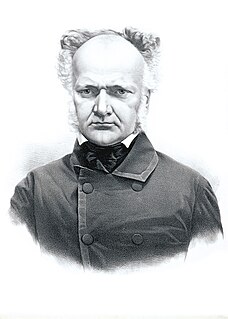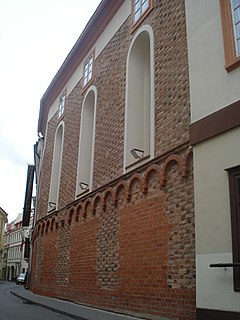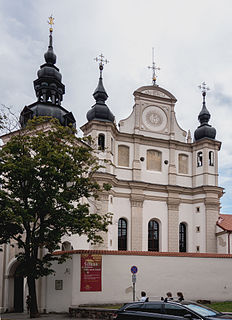
Lithuania, officially the Republic of Lithuania, is a country in the Baltic region of Europe. It is one of three Baltic states and lies on the eastern shore of the Baltic Sea. Lithuania shares land borders with Latvia to the north, Belarus to the east and south, Poland to the south, and Russia to the southwest. It has a maritime border with Sweden to the west on the Baltic Sea. Lithuania covers an area of 65,300 km2 (25,200 sq mi), with a population of 2.8 million. Its capital and largest city is Vilnius; other major cities are Kaunas and Klaipėda. Lithuanians belong to the ethno-linguistic group of the Balts and speak Lithuanian, one of only a few living Baltic languages.

The Ignalina Nuclear Power Plant is a decommissioned two-unit RBMK-1500 nuclear power station in Visaginas Municipality, Lithuania. It was named after the nearby city of Ignalina. Due to the plant's similarities to the infamous Chernobyl Nuclear Power Plant in both reactor design and lack of a robust containment building, Lithuania agreed to close the plant as part of its accession agreement to the European Union. Unit 1 was closed in December 2004; Unit 2, which counted for 25% of Lithuania's electricity generating capacity and supplied about 70% of Lithuania's electrical demand, was closed on December 31, 2009. Proposals have been made to construct a new nuclear power plant at the same site, but plans have not materialised since then.

Count Eustachy Tyszkiewicz, Leliwa coat of arms, was a Polish noble from the Tyszkiewicz family. He was an archaeologist and historian of the former Grand Duchy of Lithuania and White Ruthenia, then part of the Russian Empire. He is considered the first archaeologist to have undertaken a systematic study of historical sites in Belarus and Lithuania, and was highly influential on succeeding generations of archaeologists. In 1855 he founded the Museum of Antiquities in Vilnius, which is regarded as the predecessor institution of the National Museum of Lithuania. He donated his personal collection of archaeological and historical artifacts to start the museum. He was a younger brother of historian Konstanty Tyszkiewicz.

The Palace of the Grand Dukes of Lithuania is a palace in Vilnius, Lithuania. It was originally constructed in the 15th century for the rulers of the Grand Duchy of Lithuania and the future Kings of Poland. The palace, located in the lower castle of Vilnius, evolved over the years and prospered during the 16th and mid-17th centuries. For four centuries the palace was the political, administrative and cultural centre of the Polish–Lithuanian Commonwealth. It was demolished in 1801. Work on a new palace started in 2002 on the site of the original building and it took 16 years to complete it in 2018. The palace was rebuilt in Renaissance style to match the Cathedral of Vilnius and, according to the testimony of one of the couriers of Grand Duchess Bona Sforza, such initial reconstruction from 1520 to 1530 cost 100,000 gold ducats and was ordered by Grand Duke Sigismund I the Old. It is believed that the reconstruction was made for the proclamation ceremonies of Sigismund II Augustus, the only son of Sigismund I the Old, as the Grand Duke of Lithuania.

The Vilnius Castle Complex is a group of cultural, and historic structures on the left bank of the Neris River, near its confluence with the Vilnia River, in Vilnius, Lithuania. The buildings, which evolved between the 10th and 18th centuries, were one of Lithuania's major defensive structures.

Lithuania attracts many visitors from neighbouring countries and all over the world. In 2018, 1,7 million foreign visitors arrived to Lithuania for business, family and leisure. Historical legacy of the Grand Duchy of Lithuania, rich history, architecture, pristine nature, seaside and SPA resorts are the main attraction points of Lithuania. Domestic tourism is also highly popular - in 2018 it grew by 12% percent. Lithuanians also prefer to spend their vacations in Lithuania - 70 percent.

Ignitis Group is a state-controlled energy holding company located in Vilnius, Lithuania. Its subsidiaries are involved in power and heat generation and distribution, natural gas trade and distribution, and supporting services.
The Science and Encyclopaedia Publishing Centre is a Lithuanian publishing house that specializes in encyclopedias, reference works, and dictionaries. The Institute, headquartered in Vilnius, is supported by the Lithuanian Republic's Ministry of Education and Science.

The Museum of Occupations and Freedom Fights in Vilnius, Lithuania, was established in 1992 by order of the Minister of Culture and Education and the president of the Lithuanian Union of Political Prisoners and Deportees. In 1997, it was transferred to the Genocide and Resistance Research Centre of Lithuania. The museum is located in the former KGB headquarters across from the Lukiškės Square and is informally referred to as the KGB Museum.

The Genocide and Resistance Research Centre of Lithuania is a state-funded research institute in Lithuania dedicated to "the study of genocide, crimes against humanity, and war crimes in Lithuania; the study of the persecution of local residents by occupying regimes; the study of armed and unarmed resistance to occupying regimes; the initiation of the legal evaluation of the activities of the organisers and implementers of genocide; and the commemoration of freedom fighters and genocide victims." The centre was founded on 25 October 1992 by the Supreme Council of the Lithuanian Republic as the "State Genocide Research Centre of Lithuania". It is a member organisation of the Platform of European Memory and Conscience.
Lithuania is a net energy importer. Primary energy use in Lithuania was 98 TWh, or 29 TWh per million people in 2009.

Renewable energy in Lithuania constitutes some energy produced in the country. In 2016, it constituted 27.9% of the country's overall electricity generation. Previously, the Lithuanian government aimed to generate 23% of total power from renewable resources by 2020, the goal was achieved in 2014 (23.9%).

Plungė Manor is a former Ogiński residential manor in Plungė, Lithuania. It now harbors the Samogitian art museum.

St Michael's Church or St. Michael the Archangel Church is a former Roman Catholic church in Vilnius' Old Town, on the right bank of the Vilnia River. It now hosts the Church Heritage Museum.

Užulėnis is a village in Ukmergė District Municipality, Vilnius County, Lithuania. According to the 2001 census, the village had a population of 90 people. The population decreased to 68 at the time of the 2011 census. The village is the birthplace of the first President of Lithuania Antanas Smetona.

MO Museum is a modern art museum in Vilnius, Lithuania. As a private initiative of Lithuanian scientists and philanthropists Danguolė Butkienė and Viktoras Butkus, it functioned as an art museum without walls for about ten years. The collection of 5,000 modern and contemporary pieces contains major Lithuanian artworks from the 1950s to this day.

The Museum of Antiquities in Vilnius was a museum of archaeology and history established by Count Eustachy Tyszkiewicz in 1855 at the premises of the closed Vilnius University. It was the first public museum in the former Grand Duchy of Lithuania and is considered a predecessor of the National Museum of Lithuania even though only a handful of items from the Museum of Antiquities ended up at the National Museum. Together with the Archaeological Commission which functioned as a de facto learned society, the museum was the most prominent cultural and scientific institution in all of Lithuania and displayed many historical items that reminded of the old Grand Duchy and served romantic nationalism of Lithuanian nobles at the time when Lithuania was part of the Russian Empire. The museum collections rapidly grew to over 67,000 items in 1865 by absorbing large collections of minerals and zoological specimens from the closed Vilnius University, libraries of various closed Catholic churches and monasteries, and various donations from local nobles.

Lithuanian Theater, Music and Cinema Museum is a museum in Vilnius, Lithuania. It is located in the Minor Radvilos Palace. The material stored in the Museum reflects life, creation, and spiritual experience of Lithuanian artists. The Museum accumulates, preserves and examines showpieces related to the history of Lithuanian theatre, music, and cinema, organize evenings in commemoration of artists of these spheres, and exhibitions of collections, conducts exhaustive topical excursions and educational programs, prepare educational publications and consult visitors. Communicating with foreign institutions, international exhibitions are also held there to present significant artists of foreign countries. Furthermore, modern art exhibitions are held there, and summers are especially rich with various events in the amphitheatre of the Museum.


















